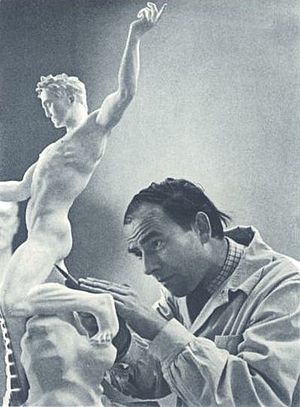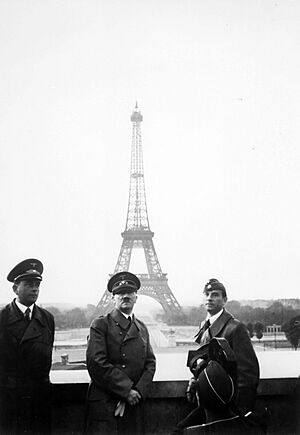Arno Breker facts for kids
Quick facts for kids
Arno Breker
|
|
|---|---|

(1930s)
|
|
| Born |
Arno Breker
19 July 1900 Elberfeld, German Empire
|
| Died | 13 February 1991 (aged 90) |
| Nationality | German |
| Known for | Sculpting, drawing |
| Olympic medal record | ||
|---|---|---|
| Art competitions | ||
| Silver | 1936 Berlin | Statues |
Arno Breker (born July 19, 1900 – died February 13, 1991) was a German artist. He was an architect and a sculptor. He is most famous for the large sculptures he made for the government in Nazi Germany. These works were supported by the leaders at the time. They were seen as the opposite of "degenerate art," which was art the Nazis did not like. One of his well-known statues is Die Partei, which means "The Party." It showed the spirit of the Nazi Party and stood at the entrance of the new government building in Berlin.
Life
Breker was born in Elberfeld, a town in western Germany. His father, Arnold Breker, was a stonemason. Arno started by studying architecture, learning how to carve stone and understand the human body. When he was 20, he joined the Düsseldorf Academy of Arts. There, he focused on sculpture.
In 1924, he visited Paris for the first time. He met famous artists and writers like Jean Cocteau and Pablo Picasso. In 1927, he moved to Paris and lived there for some time. He became friends with important people in the art world. He also traveled to North Africa and made drawings called lithographs. A famous sculptor named Aristide Maillol called Breker "Germany's Michelangelo."
In 1932, Breker won a prize that allowed him to live in Rome for a year. He returned to Germany in 1934. At first, some Nazi leaders didn't like his art. But Adolf Hitler and other powerful Nazis supported him. They saw his sculptures as showing the "strength and will" of Nazi Germany.
From 1933 to 1942, Breker created many works for the Nazi government. In 1936, he won a competition to make two sculptures for the 1936 Olympic Games. These statues showed athletic power. In 1937, he married Demetra Messala, a model from Greece. That same year, Breker joined the Nazi Party. Hitler made him the "official state sculptor." He was given a large property and a studio with many assistants. Hitler also made sure he didn't have to join the army.
His sculptures The Party and The Army were placed at the entrance of Albert Speer's new government building. He also made the “Striding Horses” in 1939. These statues stood at the garden entrance of Hitler's government building in Berlin.
Breker's art style was classical, with titles like Comradeship and Sacrifice. His sculptures often showed strong, heroic figures. They fit the ideas of Nazi art.
After World War II ended, most of Breker's public sculptures were destroyed. In 1946, he was offered work by Joseph Stalin, the leader of the Soviet Union, but he said no. In 1948, he was seen as someone who had supported the Nazis. He lost his official position and moved back to Düsseldorf. He worked as an architect and continued to make sculptures for private clients. He also made many portrait sculptures of famous people.
In 1970, the king of Morocco asked him to create art for a United Nations building. He also made portraits of leaders like Anwar el Sadat and Konrad Adenauer. Over time, people started to accept his art again. The Arno Breker Museum opened in 1985. It is located in Schloss Nörvenich, a castle between Aachen and Cologne.
However, some people were still upset about his past. When his works were shown in Paris and Berlin in 1981, there were protests. His supporters said he only accepted money from the Nazis and didn't believe in their ideas.
Breker's last big artwork was a huge sculpture of Alexander the Great. It was planned to be placed in Greece.
Marriages and family
Arno Breker was married two times. His first wife was Demetra Messala, a Greek model. She died in 1956 in a car accident. In 1958, he married Charlotte Kluge. They had two children, Gerhart (born 1959) and Carola (born 1962). Breker and Charlotte were married until he passed away in 1991.
Images for kids
-
Arno Breker carving a portrait of Albert Speer in 1940
-
Bust of Richard Wagner in Bayreuth.
-
Die Partei, Breker's statue representing the spirit of the Nazi Party that flanked one side of the carriage entrance to Albert Speer's new Reich Chancellery.
Books by Breker
- 1983 – Schriften ("Writings") Bonn: Marco-Edition ISBN: 3-921754-19-4.
- 1987 – Begegnungen und Betrachtungen ("Encounters and Reflections") Bonn: Marco-Edition ISBN: 3-921754-27-5.
- 2000 – Über allem Schönheit ("Above All Beauty") Arnshaugk. ISBN: 3-935172-02-8
Films and videos
- Arno Breker – Harte Zeit, starke Kunst, by Arnold Fanck, Hans Cürlis, Riefenstahl-Film GmbH, Berlin (1944)
- Arno Breker – Skulpturen und Musik, by Marco J. Bodenstein, 20 minutes, Marco-Edition Bonn.
- Arno Breker – Deutsche Lebensläufe, Farbfilm 60 minutes, Marco-VG, Bonn.
- Paris-Rom-Berlin und Arno Breker, and Interview with Albert Speer. Farbfilm, 60 minutes, EKS Museum Europäische Kunst, Schloss 52388 Nörvenich.
- Zeit der Götter (1992)
See also
 In Spanish: Arno Breker para niños
In Spanish: Arno Breker para niños






